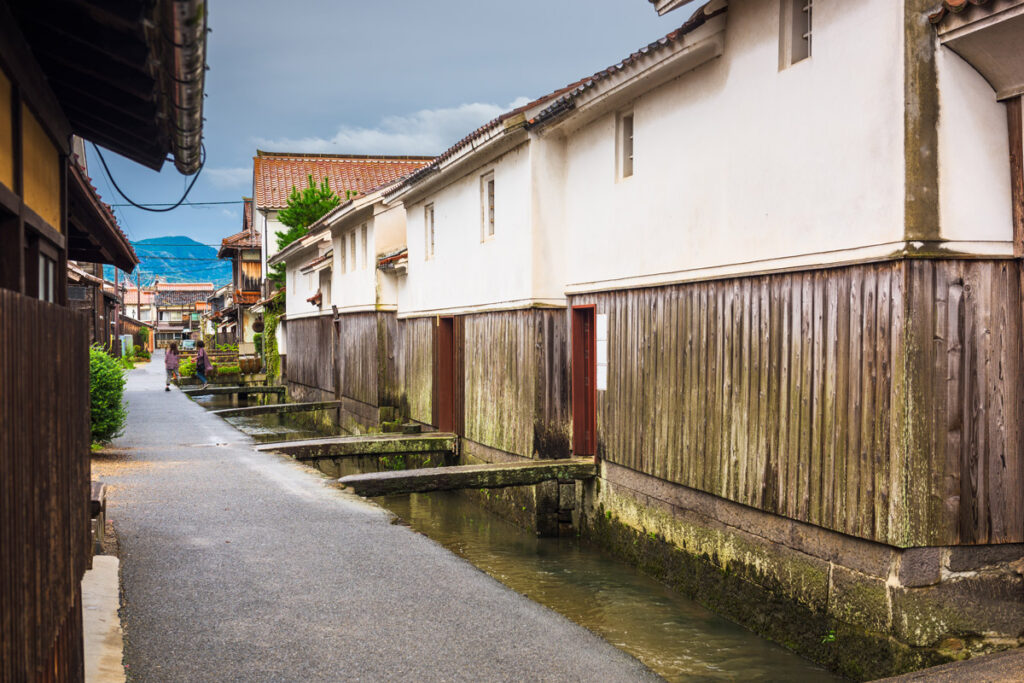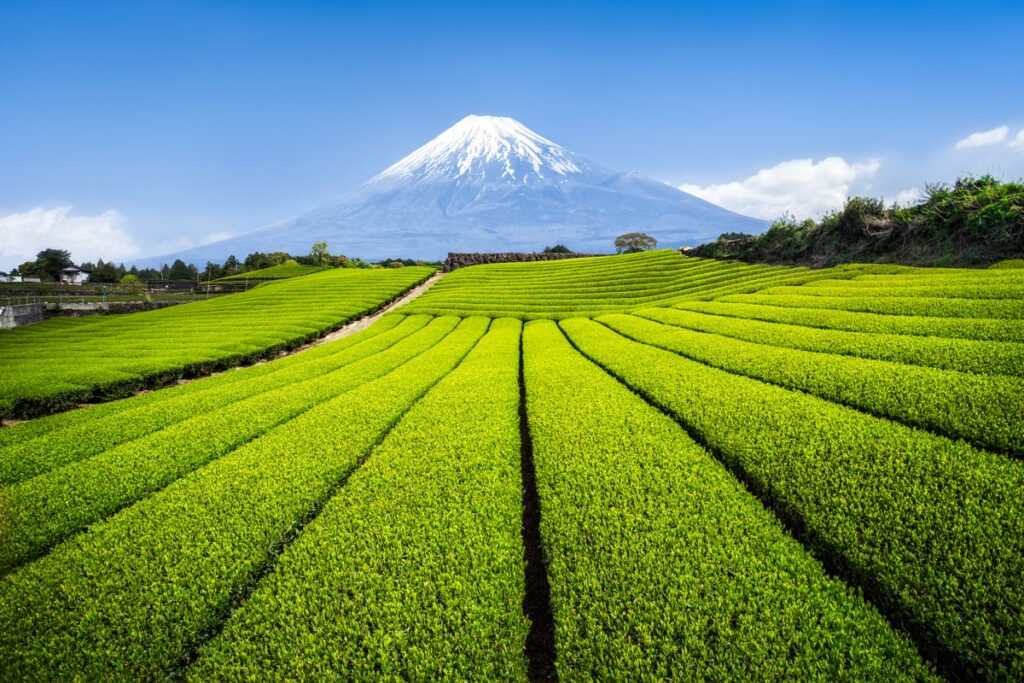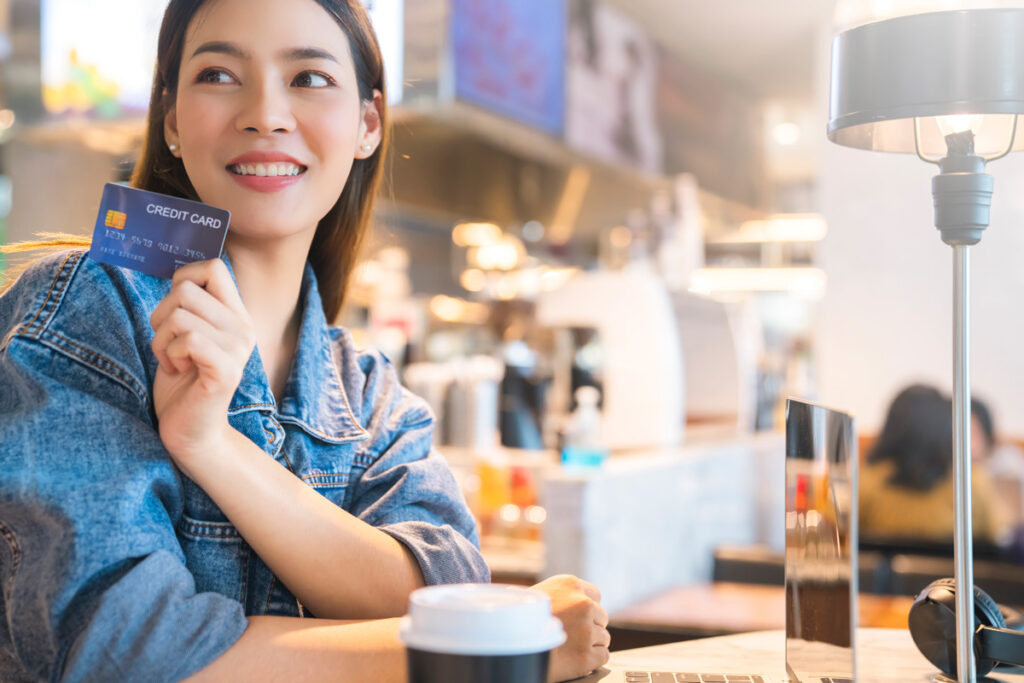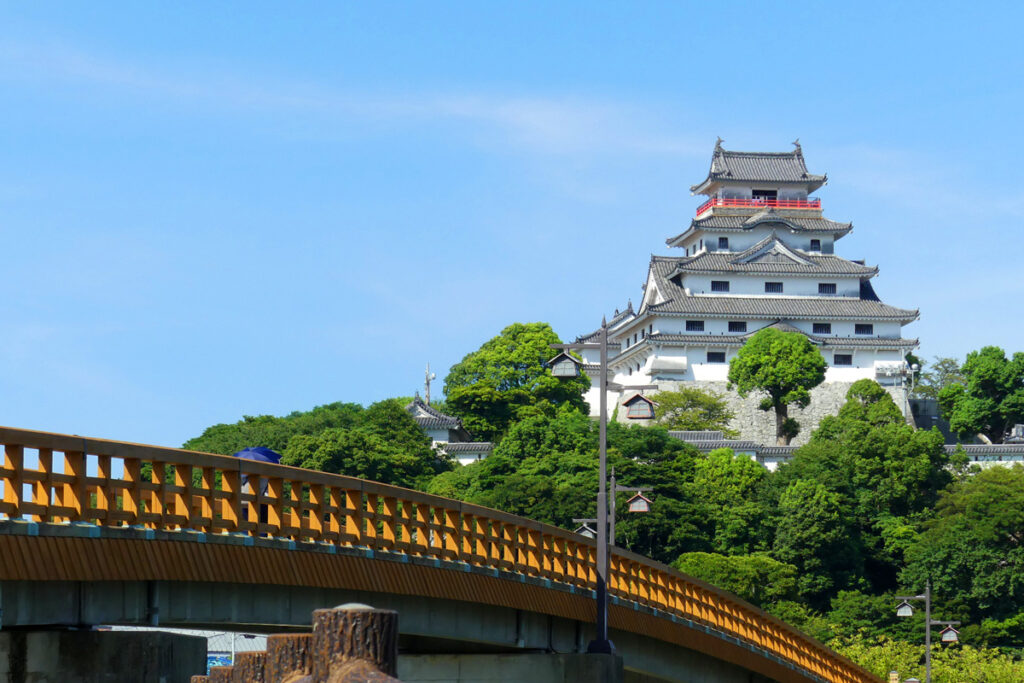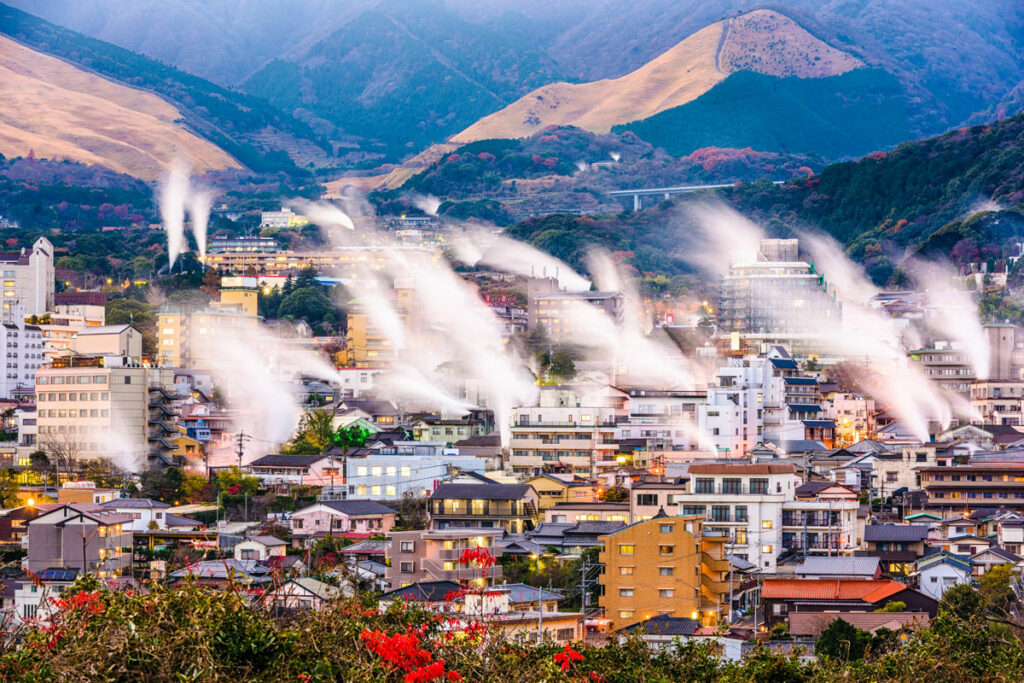Welcome to Nagano Travel guide! In this post we are going to explore the 12 top-rated things to do in Nagano, Chubu Region! Nestled in the heart of Japan’s picturesque Chubu region, Nagano is a treasure trove of cultural, historical, and natural attractions. Whether you’re a seasoned traveler or planning your first trip, this Nagano travel guide is designed to help you discover the very best of this enchanting area. From the awe-inspiring Matsumoto Castle to the tranquil beauty of Mishaka-ike Pond, we’ve got you covered. Join us as we journey through Nagano, uncovering the top spots that make this destination a must-visit in the Chubu region. Get ready to be mesmerized by the unique blend of ancient traditions and natural wonders that Nagano has to offer!
- 1. Matsumoto Castle
- 2. Snow Monkey Park
- 3. Hakuba Valley
- 4. Zenkoji Temple
- 5. Daio Wasabi Farm
- 6. Happo Pond
- 7. Kamikochi National Park
- 8. Matsumoto City Museum
- 9. Obasute Rice Terraces
- 10. Mishaka-ike Pond
- 11. Shinshu Sky Park
- 12. Kappa Bridge
- Where to Stay in Nagano for Sightseeing
- Frequently Asked Questions (FAQs)
1. Matsumoto Castle
Discover Japan’s historical elegance at Matsumoto Castle, an architectural masterpiece known for its striking black exterior and panoramic mountain views.

Matsumoto Castle (松本城) is one of the most popular tourist attractions in Nagano, Japan. It is one of the few remaining original castles in Japan, and its unique black and white exterior has earned it the nickname “Crow Castle.” It’s famed for being one of the country’s few remaining original castles, alongside Himeji and Kumamoto Castles.
The castle was built in the late 16th century, during the Warring States period. It was originally designed as a fortress, and its thick walls and many towers reflect its defensive capabilities. However, the castle also features a number of elegant details, such as its intricate carvings and beautiful gardens.
Matsumoto Castle is a popular destination for travelers of all ages. Visitors can climb to the top of the castle for stunning views of the surrounding area, and explore the castle’s interior to learn about its history and architecture. The castle also houses a museum with a collection of samurai armor, weapons, and other artifacts.
A climb to the observatory deck on the sixth floor rewards visitors with panoramic views of the city and the magnificent alps. The castle’s moat and stone walls, blooming with cherry blossoms in spring, enhance its aesthetic appeal, making it a picturesque spot for photography.
Matsumoto Castle isn’t just a journey through history, but an aesthetic feast. Its authentic charm, from the fish-shaped roof ornaments (shachi) to its moon-viewing pavilion, sets it apart as a destination that transports travelers to Japan’s illustrious feudal era, making it a must-visit for anyone touring Nagano.
Official Website: Matsumoto Castle
Address: 4-1 Marunouchi, Matsumoto, Nagano 390-0873
Reviews Visit: TripAdvisor
2. Snow Monkey Park
Experience the unique charm of wildlife in Japan at the Snow Monkey Park, where you can watch snow monkeys relaxing in natural hot springs.

Snow Monkey Park (地獄谷野猿公苑), also known as Jigokudani Monkey Park, is one of the most popular tourist attractions in Nagano, Japan. It is home to a troop of wild Japanese macaques, also known as snow monkeys, who are known for bathing in the park’s natural hot springs.
The park is located in a remote valley in the Joshinetsu-Kogen National Park. The monkeys were first observed bathing in the hot springs in the 1960s, and the park was opened to the public in 1964.
Visitors to the park can watch the monkeys from a viewing platform just a few feet away. The monkeys are not afraid of humans, and they often come very close. The best time to visit Snow Monkey Park is during the winter months, when the monkeys are most likely to be bathing in the hot springs. However, the park is open year-round, and the monkeys can be seen at any time of year.
The onsen (hot spring) bathing monkeys present a unique photography opportunity, making the Snow Monkey Park a must-visit for nature and wildlife enthusiasts. The area also features informative signages ensuring a rich, educational experience. It’s not just a visit, but an expedition into a peaceful co-existence between Japan’s wildlife and its mesmerizing natural wonders.
Official Website: Snow Monkey Park
Address: 6845 Hirao, Yamanochi, Shimotakai District, Nagano 381-0401
Reviews Visit: TripAdvisor
3. Hakuba Valley
A paradise for winter sports enthusiasts, Hakuba Valley offers world-class skiing and snowboarding experiences amidst stunning alpine scenery.
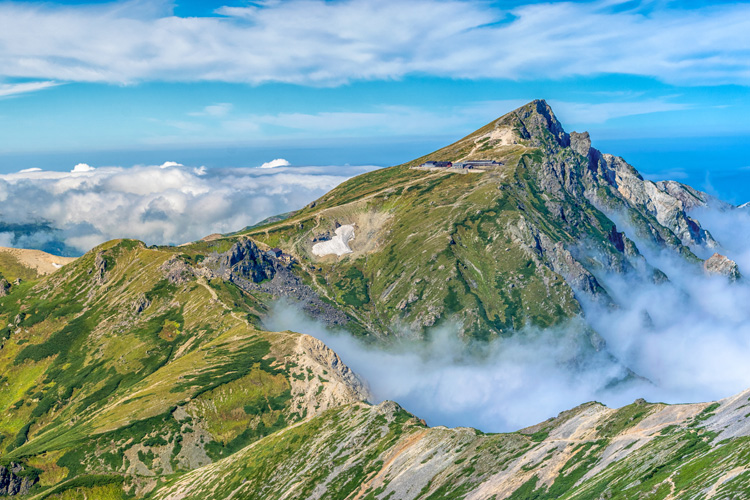
Hakuba Valley is one of the most popular ski resorts in Japan. It is located in the Nagano Prefecture, in the Japanese Alps. Hakuba Valley is home to 10 different ski resorts, each with its own unique terrain and atmosphere.
Hakuba Valley is known for its abundant snowfall and high-quality powder snow. It is also home to some of the most challenging terrain in Japan, making it a popular destination for experienced skiers and snowboarders. However, Hakuba Valley also has plenty to offer beginners and intermediate skiers and snowboarders. There are a number of gentle slopes and groomed runs, as well as a variety of ski schools and snowboard lessons available.
In addition to skiing and snowboarding, Hakuba Valley also offers a number of other winter activities, such as snowshoeing, cross-country skiing, and snowmobiling. There are also a number of hot springs in the area, where visitors can relax after a day on the slopes. Hakuba Valley isn’t merely a winter haven but a year-round outdoor adventure hub. Its diverse offerings, from the adrenaline rush of skiing to the tranquility of a hot spring bath amidst nature, make it a must-visit destination in Nagano Prefecture.
Official Website: Hakuba Valley
Address: 5723 Hokujo,Hakuba,Kitaazumi,Nagano 399-9301
Reviews Visit: TripAdvisor
4. Zenkoji Temple
Step into a spiritual haven at Zenkoji Temple, a significant pilgrimage site housing a revered Buddhist statue and exuding serene tranquility.
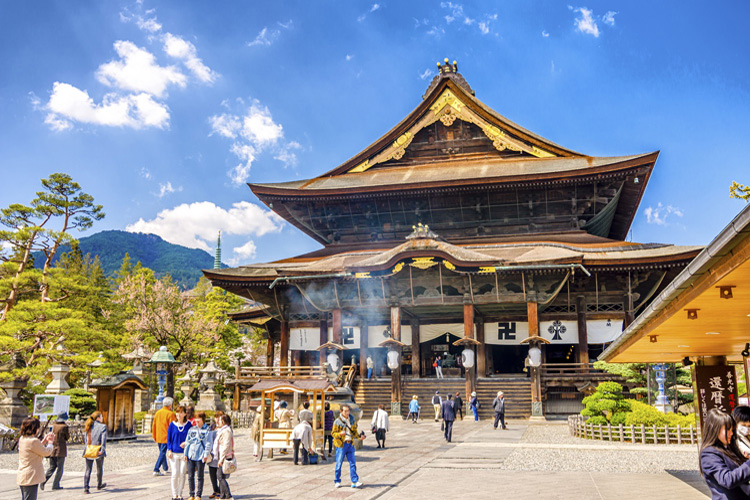
Zenkoji Temple is one of the most important Buddhist temples in Japan. It is located in the city of Nagano, and is home to a revered statue of the Buddha, which is said to be one of the few surviving images of the Buddha made during his lifetime.
The temple was founded in the 7th century, and has been a popular pilgrimage site for centuries. It is said that the temple’s main hall is a replica of the Buddha’s palace in Paradise.
Visitors to Zenkoji Temple can explore the temple grounds, which include a number of important Buddhist buildings and statues. The temple also houses a museum with a collection of Buddhist artifacts. One of the most popular attractions at Zenkoji Temple is the O-Amida-do, or inner sanctuary. Visitors can walk through the dark inner sanctuary in search of the key to Paradise, which is said to be hidden somewhere inside.
Zenkoji Temple is not only a spiritual hub but also a window into Japan’s rich historical tapestry. The serene ambiance, coupled with the profound cultural experience it offers, makes Zenkoji a must-visit spot on any Nagano itinerary, providing a peaceful retreat amidst the hustle of modern travel.
Official Website: Zenkoji Temple
Address: 491-イ, Motoyoshicho Nagano, 380-0851
Reviews Visit: TripAdvisor
5. Daio Wasabi Farm
Explore the largest wasabi farm in Japan, Daio Wasabi Farm, and delight in various wasabi-infused specialties in a picturesque setting.

Daio Wasabi Farm is one of the largest and most famous wasabi farms in Japan. It is located in the town of Azumino, in Nagano Prefecture. The farm was founded in 1915, and has been producing high-quality wasabi ever since.
Wasabi is a Japanese horseradish that is used as a condiment in Japanese cuisine. It is known for its unique flavor and aroma. Wasabi is a delicate plant, and it requires very specific conditions to grow. Daio Wasabi Farm provides the perfect environment for wasabi cultivation, with its clear, cold water and abundant sunlight.
Visitors to Daio Wasabi Farm can take a guided tour of the farm to learn about the wasabi growing process. They can also sample fresh wasabi dishes at the farm’s restaurant. In addition to wasabi, Daio Wasabi Farm also produces a variety of other Japanese vegetables, such as shiso, mitsuba, and watercress. The farm also has a gift shop where visitors can purchase wasabi products, such as wasabi powder, wasabi paste, and wasabi cookies.
Daio Wasabi Farm isn’t merely a farm; it’s an experience that combines agricultural tradition with the serene beauty of nature, offering a peaceful yet enlightening excursion to its visitors. This place is a must-visit for anyone seeking a blend of culinary and natural exploration in Nagano.
Official Website: Daio Wasabi Farm
Address: 3640 Hotaka, Azumino, Nagano 399-8303
Reviews Visit: TripAdvisor
6. Happo Pond
Embark on a scenic hike to Happo Pond, where the breathtaking reflections of the Northern Alps create a tranquil and mesmerizing atmosphere.
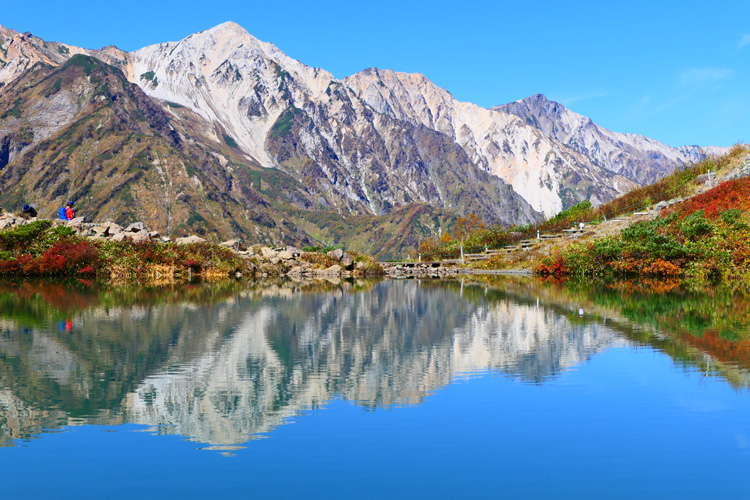
Happo Pond is a beautiful alpine lake located in the Hakuba Valley of Nagano Prefecture, Japan. It is situated at an altitude of 2,080 meters, and is surrounded by towering mountains and lush forests.
The pond is a popular destination for hikers, photographers, and nature lovers. The water is crystal clear, and the surrounding scenery is simply breathtaking. Visitors can enjoy a variety of activities at Happo Pond, including: Hiking, Photography, Fishing and Swimming.
The tranquil ambiance of Happo Pond makes it a perfect spot for contemplation and photography. Whether you’re a seasoned hiker or someone seeking a peaceful retreat, Happo Pond is a must-visit destination that promises a soul-soothing experience amidst the awe-inspiring beauty of Nagano.
Official Website: Happo Pond
Address: Hokujo, Hakuba, Kitaazumi District, Nagano 399-9301
Reviews Visit: TripAdvisor
7. Kamikochi National Park
Immerse yourself in the untouched beauty of Kamikochi National Park, featuring lush landscapes, serene rivers, and the dramatic Japanese Alps.
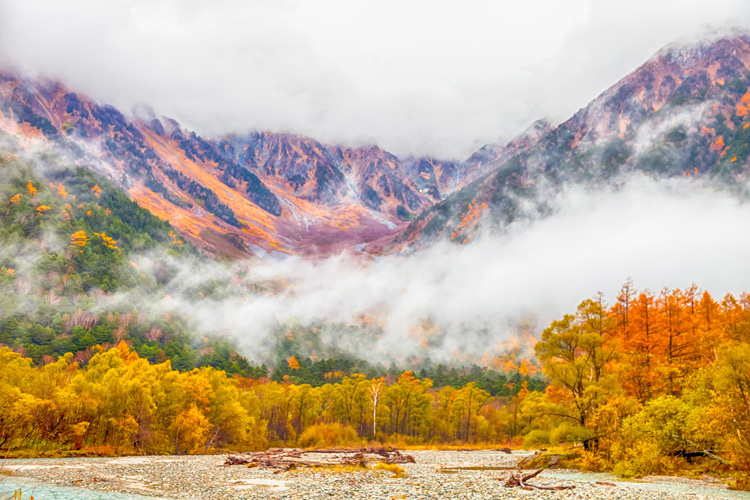
Kamikochi National Park is a stunning alpine park located in the Japanese Alps. It is known for its towering mountains, crystal-clear rivers, and lush forests. The park is a popular destination for hikers, campers, and photographers.
The heart of Kamikochi is the Kappa Bridge, a wooden suspension bridge offering panoramic views of the surrounding scenery, making it a perfect starting point for explorations. Numerous well-marked trails sprawl from this point, catering to hikers of all levels.
The hike alongside the Azusa River is a tranquil experience, with the calm waters reflecting the sky and mountains. Further along the trails, you may encounter serene ponds, and possibly local wildlife, immersing you in the untouched beauty of the region.
Camping sites and lodges are available for those wishing to extend their stay in this serene wilderness. The presence of on-site amenities ensures a comfortable experience, even amidst the rustic setting.
Kamikochi National Park is a realm of tranquility and natural splendor that allows travelers to step away from the bustle and into a world where nature reigns supreme. It’s a must-visit for those seeking a peaceful retreat or an active outdoor adventure in Nagano.
Official Website: Kamikochi National park
Address: Matsumoto, Nagano 390-1516
8. Matsumoto City Museum
Dive into the rich cultural heritage of the region at Matsumoto City Museum, showcasing intriguing exhibits and the city’s historical evolution.

Matsumoto City Museum is a comprehensive museum that tells the story of Matsumoto City, Nagano Prefecture, Japan, from its prehistoric past to the present day. The museum is located in a former school building, which was built in 1876. The museum’s collection includes a variety of artifacts, including archaeological finds, historical documents, and works of art.
One of the highlights of the Matsumoto City Museum is the permanent exhibition on the history of Matsumoto Castle. The exhibition features a variety of displays on the castle’s construction, its role in Japanese history, and its unique architecture.
Another highlight of the museum is the collection of works by Yayoi Kusama, a world-renowned Japanese artist who was born in Matsumoto. The museum’s Kusama collection includes a variety of paintings, sculptures, and installations.
Matsumoto City Museum is a must-visit for history buffs and anyone keen to gain a deeper understanding of the region’s cultural fabric. It’s a place where the past resonates amidst the modern cityscape, offering a fulfilling and educational excursion.
Official website: Matsumoto City Musuem
Address: 3-chōme-2-21 Ōte, Matsumoto, Nagano 390-0874
Reviews Visit: TripAdvisor
9. Obasute Rice Terraces
Witness the stunning beauty and intricate artistry of agriculture at Obasute Rice Terraces, particularly enchanting during sunset hours.

Obasute Rice Terraces are a stunning series of rice terraces located in the town of Obuse, Nagano Prefecture, Japan. The terraces are said to have been built over 400 years ago, and they are one of the most popular tourist attractions in the area.
The Obasute Rice Terraces are known for their unique beauty and their historical significance. The terraces are located on a steep slope, and they offer stunning views of the surrounding mountains and valleys. The terraces are also a reminder of the hard work and dedication of the Japanese people, who have been cultivating these lands for centuries.
One of the most captivating sights here is the moonlight scenery, where the terraces filled with water reflect the moon, creating a mesmerizing silvery landscape. This sight is especially enchanting during the full moon and has been celebrated in poems and songs over centuries.
Visitors can take a leisurely stroll along the pathways crisscrossing the terraces, soaking in the tranquil ambiance and the panoramic vistas. The terraces offer a different kind of beauty each season, with lush greenery in spring and summer, golden hues in autumn, and a quiet, snowy serenity in winter.
A visit to the Obasute Rice Terraces is a journey into the pastoral heart of Japan. It’s a must-visit for those seeking a peaceful retreat amidst a landscape that tells tales of time, tradition, and the harmonious rhythm of nature.
Official Website: Obasute Rice Terraces
Address: Yawata, Chikuma, Nagano 387-0023
Reviews Visit: TripAdvisor
10. Mishaka-ike Pond
Discover the serene beauty of Mishaka-ike Pond, a hidden gem reflecting the picturesque beauty of Nagano’s nature in its clear, calm waters.
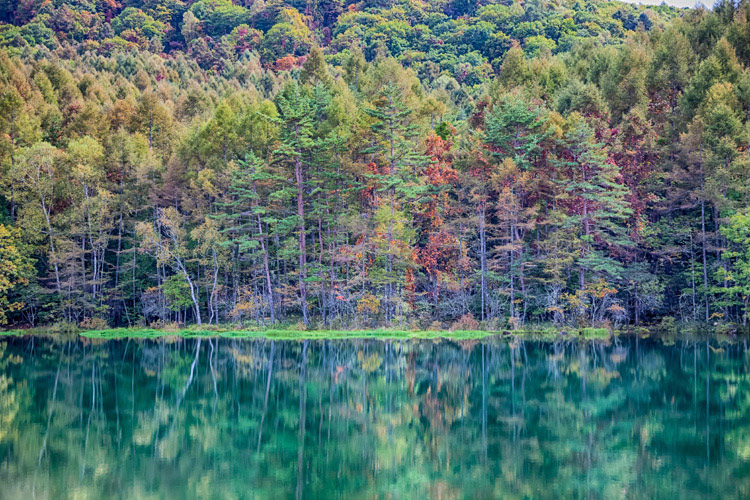
Mishaka-ike Pond, also known as Mishaka Pond, is a stunning alpine lake located in the Chino City of Nagano Prefecture, Japan. It is known for its crystal-clear waters and its mirror-like reflection of the surrounding mountains and forests. The pond is a popular destination for hikers, photographers, and nature lovers.
Mishaka-ike Pond is located at an altitude of 1,350 meters, and it is surrounded by a number of hiking trails. The most popular trail is the Mishaka-ike Pond Trail, which is a 2.5-kilometer loop trail that takes about 1 hour to complete. The trail offers stunning views of the pond and the surrounding mountains.
Mishaka-ike Pond is also a popular spot for photography. The crystal-clear waters and the mirror-like reflection of the surrounding mountains and forests offer endless opportunities to capture beautiful photos.
In addition to hiking and photography, Mishaka-ike Pond is also a great place to relax and enjoy the natural beauty of Japan. Visitors can take a walk around the pond, have a picnic on the shore, or simply sit back and enjoy the peace and quiet of the surroundings.
Mishaka-ike Pond is a must-visit for those seeking a moment of tranquility amidst the natural splendor of Nagano. It’s a place where the hustle of the modern world fades, leaving you in the peaceful embrace of nature.
Website: Mishaka-ike Pond
Address: 〒391-0213 Nagano, Chino, Toyohira, 奥蓼科
Reviews Visit: TripAdvisor
11. Shinshu Sky Park
Embrace the vibrant lavender fields and scenic cycling paths at Shinshu Sky Park, an ideal spot for relaxation and family fun in the heart of Nagano.
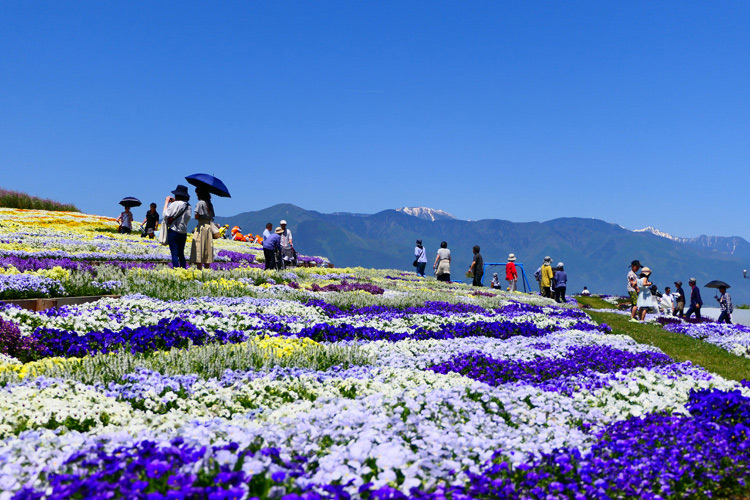
Shinshu Sky Park is a large park located in Matsumoto City, Nagano Prefecture, Japan. It is situated on a hilltop overlooking the Matsumoto Basin and the Japanese Alps. The park is a popular destination for families, couples, and nature lovers.
The park’s meticulously maintained lavender fields bloom in full glory during the summer months, presenting a spectacular sight of rolling purple hues under the clear blue sky. The bloom is accompanied by other seasonal flowers, creating a kaleidoscopic display of colors that is a delight for the senses.
One of the highlights of Shinshu Sky Park is the cycling path that winds through the fields. Rent a bicycle and leisurely explore the scenic beauty, feeling the gentle breeze as you pedal along. The path is friendly for riders of all ages, making it a delightful family outing.
Shinshu Sky Park is a must-visit for nature enthusiasts, photographers, and anyone looking to escape into a serene, colorful landscape. Its simple beauty and calming ambiance make it a cherished spot for both locals and travelers alike.
Official Website: Shinshu Sky Park
Address: 5300 Kanbayashi, Matsumoto, Nagano 390-1243
Reviews Visit: TripAdvisor
12. Kappa Bridge
Experience the serene beauty of Kamikochi at Kappa Bridge, where the majestic Japanese Alps reflect in the pristine waters of the Azusa River, creating a picturesque gateway to Nagano’s natural wonders.
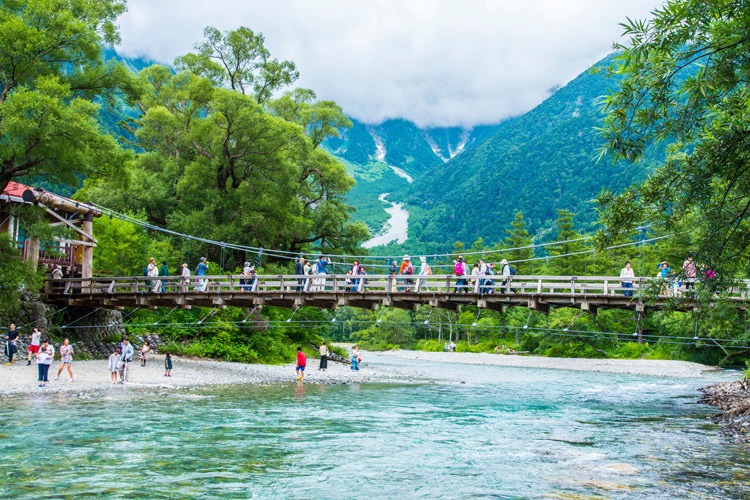
Kappa Bridge is a beautiful wooden bridge located in the town of Azumino in Nagano, Japan. It is named after the kappa, a mythical water creature that is said to live in rivers and streams. The bridge is a popular destination for hikers, photographers, and nature lovers.
Kappa Bridge is a suspension bridge that is made of wood and vine. It is 13 meters long and 2.7 meters wide. The bridge was built in the Edo period, which lasted from 1603 to 1868. It is one of the oldest wooden bridges in Japan.
Kappa Bridge is located in a beautiful setting, surrounded by mountains and forests. The bridge is a popular spot for photography, and it is also a great place to relax and enjoy the natural beauty of Japan.
Spring and summer bring a burst of greenery and wildflowers to the surrounding landscape, while autumn transforms the valley into a vibrant tapestry of reds and golds. Even in winter, the snow-covered scenery around Kappa Bridge is mesmerizing, offering a serene and peaceful experience.
A visit to Kappa Bridge is more than just a scenic stop; it’s an immersion into the natural beauty and tranquility of the Chubu region. This iconic spot is a must-visit for anyone seeking to experience the essence of Nagano’s outdoor splendor.
Official Website: Kappa Bridge
Address: Kamikochi Azumi, Matsumoto, Nagano 390-1516
Reviews Visit: TripAdvisor
Where to Stay in Nagano for Sightseeing
Whether you’re looking for luxury accommodations, mid-range options, or budget-friendly hotels, Nagano has something to suit every traveler’s needs. Here are some top picks:
Luxury Stay:
Omeitei Tsuji Ryokan is a traditional Japanese ryokan that offers a luxurious and authentic experience. The ryokan is located in the heart of Nagano, near Zenkoji Temple and Matsumoto Castle. Guests can enjoy traditional Japanese cuisine, relaxing in the onsen (hot spring baths), and beautiful tatami mats rooms.
Yadoya Shiroganeya is another traditional Japanese ryokan that offers a luxurious and authentic experience. The ryokan is located in the town of Shiga Kogen, near the ski resorts of Hakuba and Shiga Kogen. Guests can enjoy traditional Japanese cuisine, relaxing in the onsen (hot spring baths), and private hot spring baths.
Mid-Range Stay:
Nakaoyama Onsen Shyosenkaku is a traditional Japanese ryokan that offers a comfortable and relaxing experience. The ryokan is located in the town of Obuse, near the Obasute Rice Terraces. Guests can enjoy traditional Japanese cuisine, relaxing in the onsen (hot spring baths), and beautiful tatami mats rooms.
Jizokan Matsuya Ryokan is a traditional Japanese ryokan that offers a comfortable and relaxing experience. The ryokan is located in the town of Matsumoto, near Matsumoto Castle. Guests can enjoy traditional Japanese cuisine, relaxing in the onsen (hot spring baths), and private hot spring baths.
Shiori-ya is a small, family-run ryokan that offers a comfortable and affordable experience. The ryokan is located in the town of Azumino, near the Kappa Bridge. Guests can enjoy traditional Japanese cuisine, relaxing in the onsen (hot spring baths), and beautiful tatami mats rooms.
Budget Stay:
Chisun Grand Nagano is a modern hotel that offers comfortable and affordable accommodations. The hotel is located in the heart of Nagano, near Zenkoji Temple and Matsumoto Castle. Guests can enjoy a variety of amenities, including a restaurant, bar, and fitness center.
Nagano Tokyu REI Hotel is a modern hotel that offers comfortable and affordable accommodations. The hotel is located near Nagano Station, making it convenient for travelers. Guests can enjoy a variety of amenities, including a restaurant, bar, and lounge.
Hotel Metropolitan Nagano is a modern hotel that offers comfortable and affordable accommodations. The hotel is located in the heart of Nagano, near Zenkoji Temple and Matsumoto Castle. Guests can enjoy a variety of amenities, including a restaurant, bar, and fitness center.
Frequently Asked Questions (FAQs)
1. What are the top attractions to visit in Nagano?
The top attractions in Nagano include Matsumoto Castle, the Snow Monkey Park, Hakuba Valley, Zenkoji Temple, Daio Wasabi Farm, Happo Pond, Kamikochi National Park, Matsumoto City Museum, Obasute Rice Terraces, and Mishaka-ike Pond. Each offers a unique experience, from historical exploration to natural beauty.
2. Is Nagano worth visiting for outdoor enthusiasts?
Absolutely! Nagano is a paradise for outdoor enthusiasts. The Hakuba Valley is renowned for skiing and snowboarding, while Kamikochi National Park offers stunning hiking trails. Happo Pond and the Obasute Rice Terraces are perfect for scenic walks and photography.
3. When is the best time to visit Nagano, Japan?
The best time to visit Nagano, Japan, is during the summer months (June-August), when the weather is warm and sunny. However, Nagano is also a beautiful place to visit during the winter months (December-February), when the snow-capped mountains create a stunning backdrop for skiing and snowboarding.
4. How can I get to Nagano, Japan?
There are a few different ways to get to Nagano, Japan. The easiest way is to fly into Narita International Airport (NRT) or Haneda Airport (HND) in Tokyo and then take the train to Nagano Station. You can also fly into Matsumoto Airport (MMJ), which is located closer to Nagano, but there are fewer flights to this airport.
5. How accessible are the natural attractions in Nagano?
Many natural attractions in Nagano are easily accessible. Kamikochi National Park and Happo Pond have well-marked trails suitable for various skill levels. Public transportation and clear signage make it convenient for travelers to access these natural wonders.

